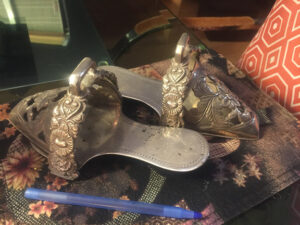 PS sent me a fascinating pair of South American stirrups SO SMALL I suspect they’re lady’s stirrups. In times past people only prized dainty lady-feet.
PS sent me a fascinating pair of South American stirrups SO SMALL I suspect they’re lady’s stirrups. In times past people only prized dainty lady-feet.
What a JOKE. When you think that when these stirrups came into existence, most women bore on an average of five kids. Who’s feet remained SMALL after carrying such loads? But the idealization of women at the time said they must have tiny little feet. Boy, do these little, tiny stirrups reflect that.
Let’s see how universal stirrups were in the 19th century, and earlier, the 18th century, and how plentiful the relics became. Few of them are worth much in the marketplace “for equipage” as we call that market.
The encased foot form Stirrups
The Spanish Colonial riding variety in the late 18th century, with a curved toe, echoed the Moorish heritage of Spain. An ornate attachment element to the saddle existed of a beautiful, foliated band with a small slot to attach to the saddle. Those will only set you back around $300 because so many existed. These are based on Spanish SOLID BRASS stirrups that show the shape of the foot. In California we see a history of those kind of stirrups.
Other countries, other forms
Japanese stirrups of the late 19th century, called “Abumi,” also small, form of a “C” shape. Not encasing the foot, but resting the foot on the bottom of that “C” shape. Beautiful in their sparsity these are usually of both bronze and brass, and worth at their most elegant $1,500. If you find a pair of Abumi cast iron lacquered over with a beautiful gold-gilt inlay, then you found something great. But I bet you will think them modern abstract works of art, and you might never recognize them as stirrups from the 19th century. They’re THAT beautiful and functional you cannot they’re meant for feet. Imagine a wonderful curve in a C shape highly decorated, from the Meiji period (1868- 1911) selling for upwards of $2,000 the pair.
Hundred percent American stirrups of the 19th century
We find not only our underlying American consumerism at work, but stirrups created to support political candidates! What a change from the elegant non-linear Japanese form and the functional ancient Spanish form. In America of the 19th century high-styled stirrups needed to support something other than the FOOT.
A case in point are the stirrups made for the candidacy of Henry Clay, the Speaker of the House in the 19th century who ran in the 1844 Presidential Campaign. You might guess he loved horses, coming from the State of Kentucky, and he bred horses. His campaign created stirrups that instead of a pretty foot support, it included an initial band which read ‘HCLAY’ that your feet rested on.
The fun part
Henry Clay LOST the presidential campaign but DID something for the horse culture of the mid-19th century. He raised “OLD HENRY CLAY,” America’s National Thoroughbred Trotting Horse. His progeny sired the magnificent “Clay Line” of great trotting horses, so much so that after the GREAT Henry CLAY passed away peacefully in 1867 (the horse, not the candidate), the remains were exhumed, and his mandible was set up on display at the Smithsonian Institute in Washington DC.
PS didn’t ask about the history of stirrups, but I hers are indeed South American, Brazilian Britannica Metal (not very much silver content at all) in the style of Conquistador stirrups from the third quarter 19th century, perhaps by the great Brazilian ironmonger Correa de Lima, Rio de Janeiro (1861-1873). A similar pair sold at New Orleans Auctions for $300.